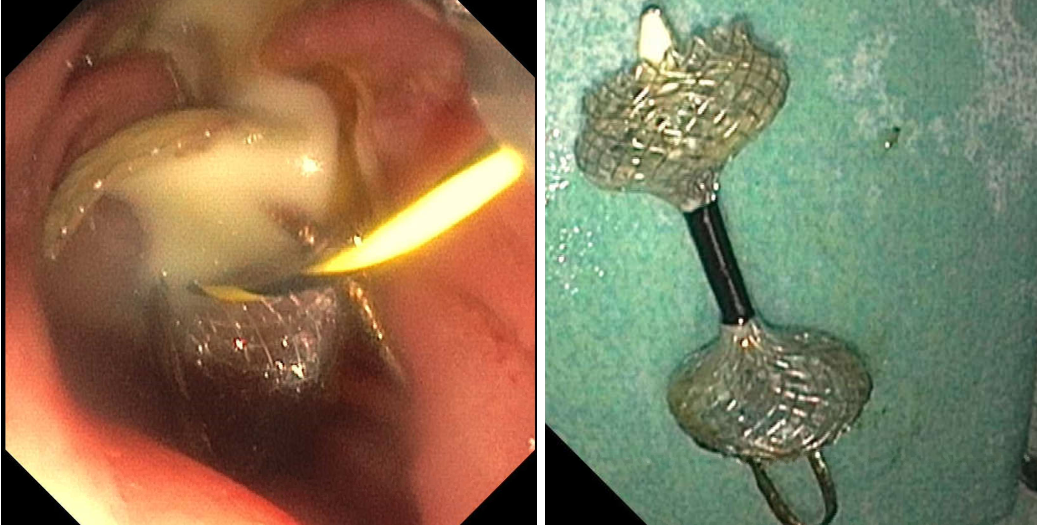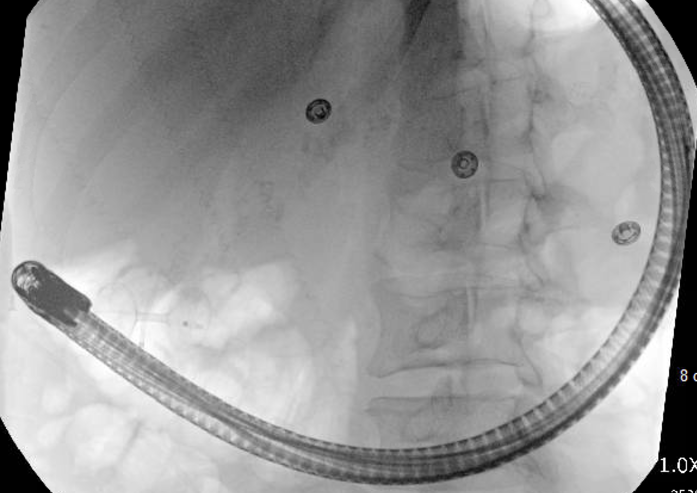Tuesday Poster Session
Category: Interventional Endoscopy
P5751 - Lumen-Apposing Metal Stent: An Epic Fail
Tuesday, October 28, 2025
10:30 AM - 4:00 PM PDT
Location: Exhibit Hall

Ahmed Shehadah, MD (he/him/his)
United Health Services, Wilson Medical Center
Binghamton, NY
Presenting Author(s)
Award: ACG Presidential Poster Award
Ahmed Shehadah, MD1, Usama Sakhawat, MD2, Alshaima Yousef, MD3, Khandokar Talib, MD4, Sadia Tabassum, MD1, AbdulSubhan Talpur, MD1, Prajjwol D. Bhatta, MD3, Amanke Oranu, MD1, Toseef Javaid, MD2
1United Health Services, Wilson Medical Center, Binghamton, NY; 2United Health Services, Wilson Medical Center, Johnson City, NY; 3Rochester General Hospital, Rochester, NY; 4United Health Services, Johnson City, NY
Introduction: Bleeding, perforation, failure of distal flange deployment, and stent misdeployment are well-known complications of lumen apposing metal stent (LAMS) placement. However, failure of LAMS expansion despite adequate placement has not been previously reported. We report a rare complication of failure of LAMS expansion despite adequate deployment and its management.
Case Description/
Methods: A 43-year-old male with a history of alcohol-induced chronic pancreatitis presented with fever, severe abdominal pain, vomiting and leukocytosis. Computed tomography (CT) abdomen/ pelvis revealed a 6 cm pancreatic pseudocyst with internal debris, raising suspicion for infection. Endoscopic ultrasound (EUS) demonstrated a 6 x 6.3 cm pseudocyst in the pancreatic head.
The decision was made to proceed with a 15 x 10 mm LAMS to drain the cyst. EUS-guided cystoduodenostomy (EUS-CD) was done in standard fashion. The distal flange was successfully deployed. The proximal flange was deployed within the scope channel and pushed out using standard technique, however, the introducer catheter could not be disengaged from the stent. Positioning was adequate. Pus drainage was noted, however, sluggish due to failure of LAMS expansion. Endoscopic images while manipulating the proximal flange showed the black sheath covering the saddle of the LAMS. Despite multiple attempts, the inner catheter could not be disengaged from the LAMS. In order to salvage the LAMS, the endosonoscope was apposed against the proximal flange under fluoroscopic guidance and the delivery system was pulled, resulting in the breakage of the introducer catheter from the inner catheter. The cyst cavity was cannulated using a 0.035-inch guidewire, the dilating balloon catheter could not be advanced due to the plastic sheath covering the LAMS saddle. The stent was left in place to allow drainage albeit slowly.
A follow-up CT performed 5 days later demonstrated decompression of the cyst. The patient then underwent repeat endoscopy with LAMS removal 5 days later, with replacement of LAMS with a double pigtail stent.
Discussion: This case highlights the challenges of managing mechanical complications of LAMS. In our case, apposing the endosonoscope against the proximal flange while using repeated tension disengaged the delivery catheter and saved the day. In our case, the error may have been attributable to a potential manufacturer defect. Other hypothetical causes include excessive torque, use of the elevator, and inadequate electrocautery settings.

Figure: The picture on the left shows the proximal flange with an inner guidewire and pus draining.
The picture on the right shows LAMS post removal, with a black sheath covering the saddle.

Figure: Fluoroscopy image demonstrating LAMS in adequate position, proximal and distal flange, and inadequate stent expansion.
Disclosures:
Ahmed Shehadah indicated no relevant financial relationships.
Usama Sakhawat indicated no relevant financial relationships.
Alshaima Yousef indicated no relevant financial relationships.
Khandokar Talib indicated no relevant financial relationships.
Sadia Tabassum indicated no relevant financial relationships.
AbdulSubhan Talpur indicated no relevant financial relationships.
Prajjwol Bhatta indicated no relevant financial relationships.
Amanke Oranu indicated no relevant financial relationships.
Toseef Javaid indicated no relevant financial relationships.
Ahmed Shehadah, MD1, Usama Sakhawat, MD2, Alshaima Yousef, MD3, Khandokar Talib, MD4, Sadia Tabassum, MD1, AbdulSubhan Talpur, MD1, Prajjwol D. Bhatta, MD3, Amanke Oranu, MD1, Toseef Javaid, MD2. P5751 - Lumen-Apposing Metal Stent: An Epic Fail, ACG 2025 Annual Scientific Meeting Abstracts. Phoenix, AZ: American College of Gastroenterology.
Ahmed Shehadah, MD1, Usama Sakhawat, MD2, Alshaima Yousef, MD3, Khandokar Talib, MD4, Sadia Tabassum, MD1, AbdulSubhan Talpur, MD1, Prajjwol D. Bhatta, MD3, Amanke Oranu, MD1, Toseef Javaid, MD2
1United Health Services, Wilson Medical Center, Binghamton, NY; 2United Health Services, Wilson Medical Center, Johnson City, NY; 3Rochester General Hospital, Rochester, NY; 4United Health Services, Johnson City, NY
Introduction: Bleeding, perforation, failure of distal flange deployment, and stent misdeployment are well-known complications of lumen apposing metal stent (LAMS) placement. However, failure of LAMS expansion despite adequate placement has not been previously reported. We report a rare complication of failure of LAMS expansion despite adequate deployment and its management.
Case Description/
Methods: A 43-year-old male with a history of alcohol-induced chronic pancreatitis presented with fever, severe abdominal pain, vomiting and leukocytosis. Computed tomography (CT) abdomen/ pelvis revealed a 6 cm pancreatic pseudocyst with internal debris, raising suspicion for infection. Endoscopic ultrasound (EUS) demonstrated a 6 x 6.3 cm pseudocyst in the pancreatic head.
The decision was made to proceed with a 15 x 10 mm LAMS to drain the cyst. EUS-guided cystoduodenostomy (EUS-CD) was done in standard fashion. The distal flange was successfully deployed. The proximal flange was deployed within the scope channel and pushed out using standard technique, however, the introducer catheter could not be disengaged from the stent. Positioning was adequate. Pus drainage was noted, however, sluggish due to failure of LAMS expansion. Endoscopic images while manipulating the proximal flange showed the black sheath covering the saddle of the LAMS. Despite multiple attempts, the inner catheter could not be disengaged from the LAMS. In order to salvage the LAMS, the endosonoscope was apposed against the proximal flange under fluoroscopic guidance and the delivery system was pulled, resulting in the breakage of the introducer catheter from the inner catheter. The cyst cavity was cannulated using a 0.035-inch guidewire, the dilating balloon catheter could not be advanced due to the plastic sheath covering the LAMS saddle. The stent was left in place to allow drainage albeit slowly.
A follow-up CT performed 5 days later demonstrated decompression of the cyst. The patient then underwent repeat endoscopy with LAMS removal 5 days later, with replacement of LAMS with a double pigtail stent.
Discussion: This case highlights the challenges of managing mechanical complications of LAMS. In our case, apposing the endosonoscope against the proximal flange while using repeated tension disengaged the delivery catheter and saved the day. In our case, the error may have been attributable to a potential manufacturer defect. Other hypothetical causes include excessive torque, use of the elevator, and inadequate electrocautery settings.

Figure: The picture on the left shows the proximal flange with an inner guidewire and pus draining.
The picture on the right shows LAMS post removal, with a black sheath covering the saddle.

Figure: Fluoroscopy image demonstrating LAMS in adequate position, proximal and distal flange, and inadequate stent expansion.
Disclosures:
Ahmed Shehadah indicated no relevant financial relationships.
Usama Sakhawat indicated no relevant financial relationships.
Alshaima Yousef indicated no relevant financial relationships.
Khandokar Talib indicated no relevant financial relationships.
Sadia Tabassum indicated no relevant financial relationships.
AbdulSubhan Talpur indicated no relevant financial relationships.
Prajjwol Bhatta indicated no relevant financial relationships.
Amanke Oranu indicated no relevant financial relationships.
Toseef Javaid indicated no relevant financial relationships.
Ahmed Shehadah, MD1, Usama Sakhawat, MD2, Alshaima Yousef, MD3, Khandokar Talib, MD4, Sadia Tabassum, MD1, AbdulSubhan Talpur, MD1, Prajjwol D. Bhatta, MD3, Amanke Oranu, MD1, Toseef Javaid, MD2. P5751 - Lumen-Apposing Metal Stent: An Epic Fail, ACG 2025 Annual Scientific Meeting Abstracts. Phoenix, AZ: American College of Gastroenterology.

